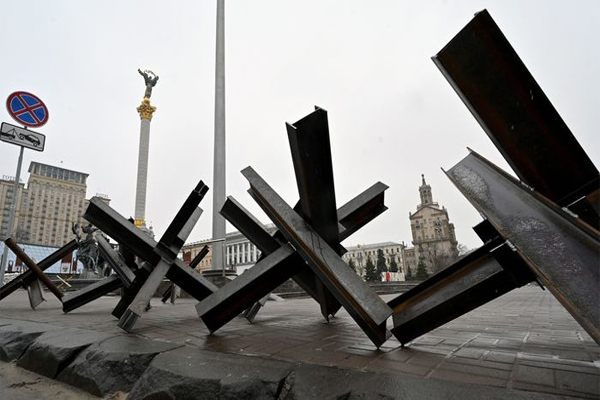
of the Ukrainian Armed Forces, at Independence Square in Kyiv.(AFP)
By Myra P. Saefong and Barbara Kollmeyer, MarketWatch
SAN FRANCISCO
EnergiesNet.com 03 03 2022
Oil prices settled above $110 a barrel on Wednesday as investor concerns mounted over potential supply disruptions from an intensifying Russia-Ukraine war.
OPEC+, made up of the Organization of the Petroleum Exporting Countries and its allies, including Russia, offered no surprises at its monthly meeting, quickly agreeing to boost production in April by another 400,000 barrels a day.
Price action
- April West Texas Intermediate crude futures CL.1, 0.60% CLJ22, 0.59% rose $7.19, or nearly 7%, to settle at $110.60 a barrel on the New York Mercantile Exchange. Front-month contract prices, which traded as high as $112.51, marked their highest finish since May 2011, according to Dow Jones Market Data.
- May Brent crude BRNK22, 0.93% BRN00, 0.92% the global benchmark, jumped $7.96, or 7.6%, to $112.93 a barrel. It logged the highest settlement since June 2014.
- April natural gas NGJ22, 1.09% rose 4.1% to $4.762 per million British thermal units.
- April gasoline RBJ22, 1.79% climbed 7.1% to $3.308 a gallon, the highest finish since September 2012.
- April heating oil RBJ22, 1.79% rose 10.9% to $3.495 a gallon, settling at the highest since July 2008.
Market drivers
Oil gains continued, with analysts commenting that the extra crude from the agreement to release 60 million barrels from the emergency oil reserves of member countries of the International Energy Agency was being viewed as a mere drop in the bucket of what would be needed to deal with potential war-linked disruptions.
“As a one-off release, it will be [in] a matter of days that it is offset by disruptions on Russian exports,” said Nicolas Daher, lead energy analyst at the Economist Intelligence Unit.
Meanwhile, global buyers shunned Russian oil, with Trafigura Group offering a deep discount on a cargo of Urals grade for $18.60 a barrel that drew no bids on Tuesday, Bloomberg and other media outlets reported.
Read: Oil surges, but history says prices eventually fall after countries release emergency reserves
Many crude buyers are have rejected buying Russian crude “as currently it is almost impossible to get insurance for cargoes sailing from Russia or to find banks willing to finance these operations,” Daher told MarketWatch. “Russian volumes are very hard to replace and buyers are competing for a reduced supply, pushing prices up.”
War in Ukraine: Both sides say ready for new talks as Russia renews assault on key city Kharkiv
Oil futures remained higher after the OPEC+ decision to continue its plan to gradually increase output.
This “modest increase” may signal that OPEC+ isn’t as concerned with higher prices as others may be, and could just be willing to stick with its original plan all the way through given that prices have already broached $100, Rohan Reddy, research analyst at Global X, told MarketWatch.
Supply data
The EIA reported on Wednesday that U.S. crude inventories fell by 2.6 million barrels for the week ended Feb. 25.
On average, the EIA was expected to show crude inventories up by 2.3 million barrels, according to analysts surveyed by Platts of S&P Global Commodity Insights. The American Petroleum Institute on Tuesday reported a 6.1 million-barrel decrease.
The EIA also reported weekly inventory declines of 500,000 barrels for gasoline and 600,000 barrels for distillates. The analyst survey showed expectations for weekly supply declines of 1.8 million barrels for gasoline and 2 million barrels for distillates.
The EIA data showed crude stocks at the Cushing, Okla., Nymex delivery hub edged down by 1 million barrels for the week, while stocks in the Strategic Petroleum Reserve fell 2.4 million barrels.
marketwatch.com 03 02 2022












